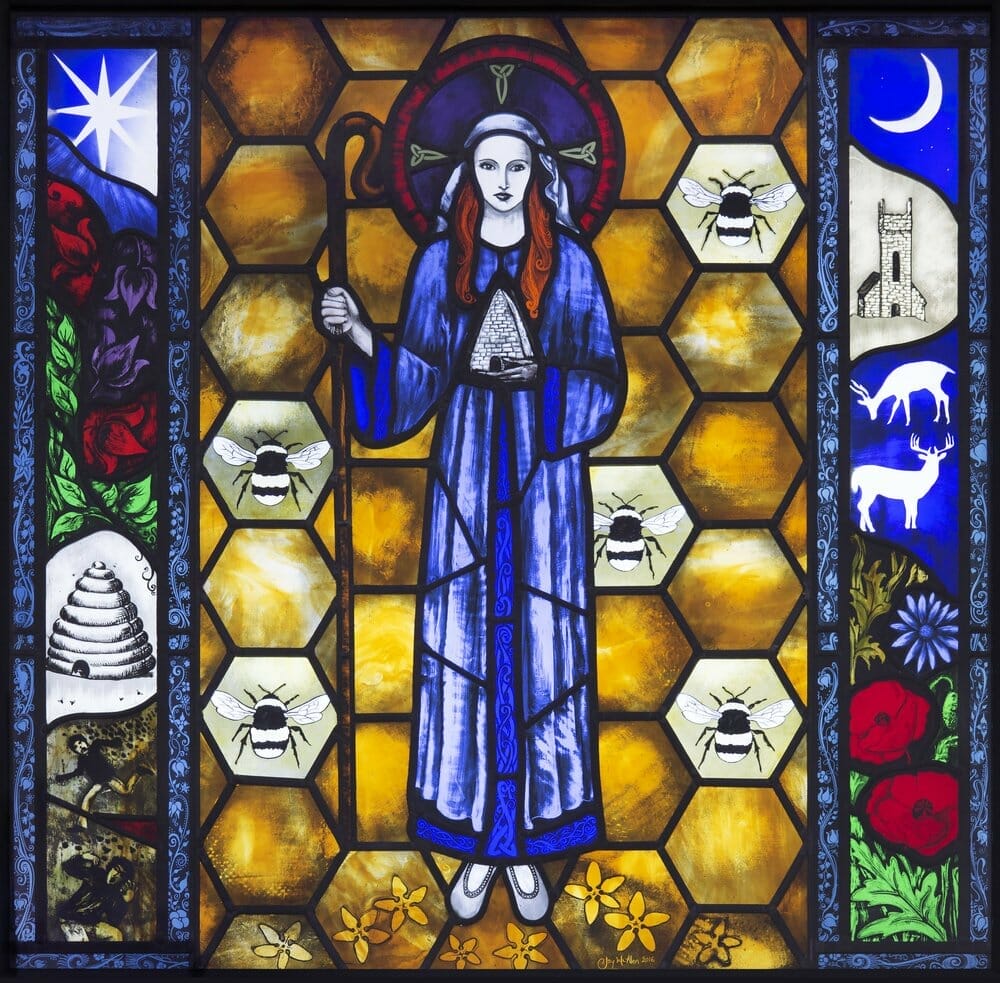Saint Gobnait: The Bee Whisper- February 11
February 11, we celebrated St Gobnait’s Feast Day, patron saint of bees and beekeepers.
The Beekeepers’ Saint Gobnait
Saint Gobnait (Irish for Deborah or Abigail), the patroness of Beekeepers and healers, is celebrated in Ballyvourney, a small town in West Cork. Her Feast Day is February 11.
Saint Gobnait is the patron saint of bees, and there are several stories
recalling her forcing invaders out of Ballyvourney by setting swarms of bees upon them.
She is also the Patron of the sick, and likely that she used honey as healing medicine.
She is regarded to be one of the 3 great Celtic healers.
Unlike many other Irish saints, Saint Gobnait’s life story was not written down during the medieval period. Tradition and links with St Abbán (associated with Ballyvourney) suggest she lived during the 6th century. By all accounts, we believe that Saint Gobnait was a Bee whisper.
A version of the saint’s life tells us that Saint Gobnait was born in Co Clare. Due to a family feud, she fled to the island of Inisheer, where she founded a church that still stands on the north side of the island near the shore.
In Search of a Place of Ressurection
One day an angel appeared to her and told her to head inland and to find the place of her resurrection.
She was told she would know this spot as it would be marked by the presence of 9 white deers.
She traveled south in search of this place. Her many stops are marked by churches and holy wells dedicated to her, such as the medieval church at Kilgobnet, Co Waterford.
At various stages of her journey, Gobnait met with white deer of varying numbers. Still, only when she reached Ballyvourney, she found the nine deer grazing on the rise overlooking the River Sullane and looking towards the Derrynasaggart hills.
This is where she settled, died, and was buried “to await her resurrection.”
Saint Abbán is said to have worked with her on the convent’s foundation and to have placed Saint Gobnait over it as abbess. As a result, saint Abigail (as she was also known) or Saint Gobnait’s cult thrived. The ruins of a medieval church dedicated to her are still visible today.
Gobnait noted that “resurrection place” where the soul leaves the body. Celtic lore believed that the soul left the body as a bee or a butterfly; thus, bees were highly esteemed.
So, it is not surprising that Gobnait added beekeeping to her life’s work developing a lifelong affinity with them.
Saint Gobnait Stories and Lore
Typical of the ecclesiastical records of the era, lots of miracle-embellished stories survive where Gobnait and her superhero bees save the day.
St. Gobnait was best known for her care of the sick. A legend tells of her staving off the plague from Ballyvourney by drawing a line in the sand with a stick and declaring the village “consecrated ground.” Today, a medieval (possibly 13th century) figure of St. Gobnait is kept in a drawer. Every year on her feast day, the parish priest brings out the figure to celebrate a devotional tradition.
One story tells of how she cured one of her sick nuns using her own honey.
And many accounts exist of how Saint Gobnait prevented several invaders from carrying off cattle. She let loose the bees from her hives while commanding the bees against them. This legend inspired the Harry Clarke-stained glass window in the Honan Chapel at University College Cork.
The beautiful window shows Saint Gobnait dressed in royal blue robes with elaborate designs in turquoise. She wears a silver cloak and a veil. Her face is surrounded by bees. She is shown carrying a honeycomb at her feet, and bees are depicted chasing away the thieves who threaten to rob her church.
One version of the tale has the beehive turning into a bronze helmet and the bees themselves turning into soldiers.

The Bronze Helmet
It is said that the O’Herlihys sought her help and that they handed down the bronze helmet from one generation to the next as a great source of protection.
Another version has the beehive turning into a bell which then became known as Saint Gobnait’s bell.
Many modern depictions of the saint also associate her with bees. One of them is the statue at her shrine in Ballyvourney, by Séamus Murphy.
As with many great stories, most likely, there is a grain of truth lurking in these stories somewhere. Saint Gobnait was obviously well revered.
Her fondness for bees suggests a calm and gentle character.
She has a considerable follower, with many people taking part in pilgrimages to her shrine in Ballyvourney. Moreover, her spirit lives on in apiary circles, where she has become quite an icon.
In this age, where bees need all the nurturing they can get, anyone who inspires beekeepers to continue their amazing work has earned sainthood several times over.
Article originally published at: Irish Examiner






